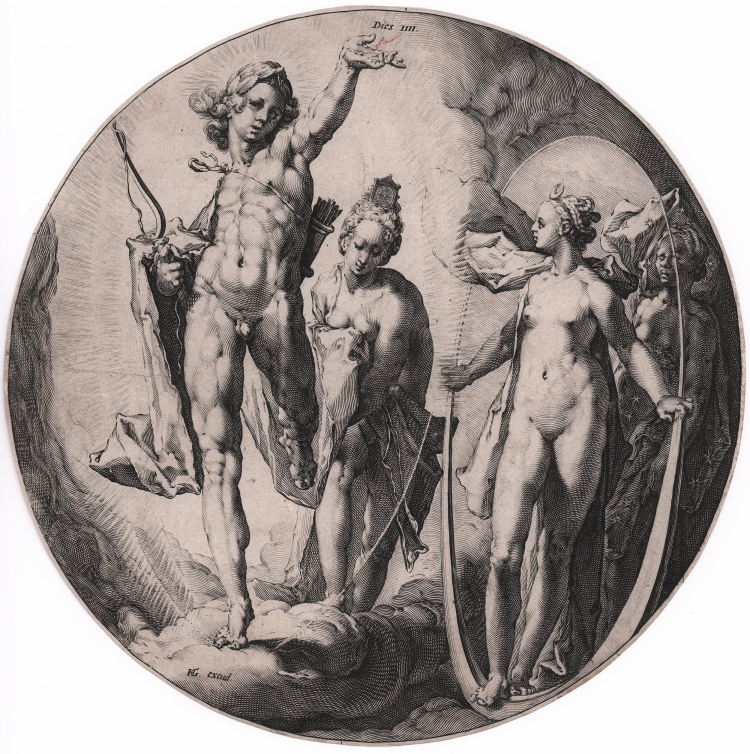



| Reference: | S40804 |
| Author | Jan Harmensz MULLER |
| Year: | 1590 |
| Measures: | 264 x 264 mm |


| Reference: | S40804 |
| Author | Jan Harmensz MULLER |
| Year: | 1590 |
| Measures: | 264 x 264 mm |
Engraving, 1590, signed on plate, left below “HG. excud.”, inscribed at top centre “Dies IIII”. Second final state, with the excudit added. After Hendrick Goltzius.
From the series “The Creation of the World” consisting of seven plates. The date – 1590 – is on the first plate of the series, with Goltzius’s signature and address, as well as Muller’s signature. Goltzius’s address on every plate.
Preliminary sketches for the prints by Goltzius in Leiden (Prentenkabinet der Rijkuniversiteit).
The composition, representing the creation of Sun, Moon and Stars, of this plate is based on Genesis 1:14-19
14 And God said, “Let there be lights in the vault of the sky to separate the day from the night, and let them serve as signs to mark sacred times, and days and years, 15 and let them be lights in the vault of the sky to give light on the earth.” And it was so. 16 God made two great lights—the greater light to govern the day and the lesser light to govern the night. He also made the stars. 17 God set them in the vault of the sky to give light on the earth, 18 to govern the day and the night, and to separate light from darkness. And God saw that it was good. 19 And there was evening, and there was morning —the fourth day.
Magnificent exemplary, rich in tones, on contemporary paper and trimmed to the copper line, small tear of paper (or fold) on the left side restored, slight stain of color at the top, otherwise in excellent condition.
|
Hollstein, 5; New Hollstein Dutch 39; J.P. Filedt Kok, 'Jan Harmensz. Muler as Printmaker - III. Catalogue', Print Quarterly 12, n. 1 (1995), p. 13.
|
Jan Harmensz MULLER (Amsterdam 1571 - 1628)
|
Dutch engraver, draughtsman and painter. He was the eldest son of Harmen Jansz. Muller (1540–1617), the Amsterdam book printer, engraver and publisher. The family business, called De Vergulde Passer (‘The gilded compasses’), was situated in Warmoesstraat, and Jan Muller worked there for many years. He may have been apprenticed to Hendrik Goltzius in Haarlem. Between 1594 and 1602 he is thought to have gone to Italy, where he stayed in Rome and Naples. He was related by marriage to the Dutch sculptor Adriaen de Vries, who was a pupil of Giambologna. He also maintained contacts with Bartholomeus Spranger and other artists in Prague, which under the rule of Emperor Rudolf II had become a flourishing centre of the arts. In 1602 he made an unsuccessful attempt to mediate on behalf of Rudolf II, who wanted to buy Lucas van Leyden’s Last Judgement. When Harmen Jansz. Muller died, he left the entire stock of his shop, including a number of copperplates, to his bachelor son Jan.
|
|
Hollstein, 5; New Hollstein Dutch 39; J.P. Filedt Kok, 'Jan Harmensz. Muler as Printmaker - III. Catalogue', Print Quarterly 12, n. 1 (1995), p. 13.
|
Jan Harmensz MULLER (Amsterdam 1571 - 1628)
|
Dutch engraver, draughtsman and painter. He was the eldest son of Harmen Jansz. Muller (1540–1617), the Amsterdam book printer, engraver and publisher. The family business, called De Vergulde Passer (‘The gilded compasses’), was situated in Warmoesstraat, and Jan Muller worked there for many years. He may have been apprenticed to Hendrik Goltzius in Haarlem. Between 1594 and 1602 he is thought to have gone to Italy, where he stayed in Rome and Naples. He was related by marriage to the Dutch sculptor Adriaen de Vries, who was a pupil of Giambologna. He also maintained contacts with Bartholomeus Spranger and other artists in Prague, which under the rule of Emperor Rudolf II had become a flourishing centre of the arts. In 1602 he made an unsuccessful attempt to mediate on behalf of Rudolf II, who wanted to buy Lucas van Leyden’s Last Judgement. When Harmen Jansz. Muller died, he left the entire stock of his shop, including a number of copperplates, to his bachelor son Jan.
|